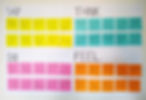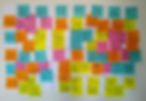UX Case Study

Overview
Design Thinking Methodology
THE CHALLENGE
The challenge was to design an app experience for someone who did not cook all the time and needed recipes. Point of view: Student in college comes home to an apartment with limited time to prepare a meal and with only certain ingredients available.
When the challenge was given, I initiated a process of research to know and understand the user. The thinking methodology was crucial to be able to walk in the shoes of a college student. Following the different steps of design thinking methodology, I was able to understand how students think and what they want, and this helped me to develop a cooking app for them.

1. EMPATHIZE

Questions
With the technique by IDEO, "How might we", I transformed different assumptions into questions.
By doing this, I was able to formulate the hypothesis of the user.
Hypothesis
We believe that: Designing an app that can organize and rank as many meals as possible in terms of limited time in a specific schedule and with limited ingredients
For: students in college
Will: Make it easier to know what to cook and how much time will it will take, having access to different balanced meals during the week according to their preferences.
Market Research
Competitive Analysis
To create a successful cooking app for college students, it was necessary to investigate different apps available and how they work. I investigated four competitors: two direct competitors and two indirect competitors. It was important to understand how they are successful and in which ways they were not successful and why. I was able to identify trends, things that they do and do not do well, and how their decisions could help me to create my cooking app.




Analyzing the indirect and direct competitors, I found that all of them knew the user very well. They had different personalization features and filters in their apps that would help the user find what there were looking for more easily. I realize that I had to simplify my hypothesis and try to achieve a specific goal. This research made me consider what things I needed to have in my app and what I did not need.
Second Hypothesis
After the research, I reformulated the hypothesis with a more specific goal.
We believe that: Designing an app that enables to cook as many meals as possible within a limited time frame.
For: students in college.
Will: Help them save time and be able to have different meals for the week.
Interviews and surveys
To know the issues and problems that college students were experiencing, I developed two types of surveys: a qualitative interview in person and a quantitative survey online.



With the interviews and surveys, I realized that students did not want to cook a lot of meals. The principal goal for them was to cook in less time and organize their week with what they wanted to eat. If they achieved those goals, it was going to be easier for them to cook and buy the necessary ingredients for the week. The interviews and survey made me realize that my hypothesis wasn't correct and I needed to rethink it.
Empathy Map
The creation of an empathy map is a way to visualize the college students, how they "look" like. With this map I can realize what the students are thinking, feling, saying, and doing.

Final Hypothesis
After the interviews and creating the empathy map, I reformulated the hypothesis. I realized that I was wrong with my assumptions, and the people were not looking to cook a lot of meals, instead of that, they wanted to cook different meals but in a short time. Also, all of them wanted to organize better and buy things with time but they did not know how to do it.
We believe that designing an app that shows how to cook different meals in a short time, for students in college, will help them to organizate and buy the necessary ingredients for the week.
2. DEFINE
Persona
The creation of a persona is helpful because you put a face and psychographic data to your user. Matias is the example of a college student that reunites the characteristics that I gathered in my interviews and surveys.

User Journey
From the user's point of view, I built a journey map of my persona. This journey map represents seven different stages that he experiences in the process of cooking a meal. With this journey map, I realized different pain points that lead me to opportunities for my app.

User Journey Redefined
Redefined journey map of my persona. In this journey map, I added the feelings of the user in different stages.

3. IDEATE
Building out a sitemap
I built a sitemap to organize my ideas and start to ideate how the app was going to be. The goal of this was to understand the "bones" of the architecture of the app.

Initial Wireframes
After building my sitemap, I started sketching out the initial wireframes. In this process, I notice that I wanted to do a lot of things and I was being very ambitious and I was losing focus on my goal. I simplified the architecture and eliminate some of the main screens. My goal was to create an app that was easy for the user and help them to organize.









Final Wireframes
After the feedback from the class, I realized that I needed to simplify the screens more. I tried to add too many interactions in the initial wireframes, and I was losing the focus of my thesis, which were the organization of the weekly meals and cook meals in a short time. Making notes on each screen made me recognize some mistakes and things that needed to be changed.
%200.png)




4. PROTOTYPE
When the final wireframes were created the prototype was the next step. Once I started the prototype I realize some of the interactions were difficult to represent and others don't work as I thought. Finally, I finish the prototype that was tested.

5. TEST
The final step of the design thinking methodology was the test. When I finished my prototype, I tested with some classmates I realized a lot of mistakes and things that I needed to improve. For example, not all the screens had interactions, and sometimes it was difficult to continue the navigation, also the bottoms and numbers were too small, and the finger didnt recognize it. The prototype and test stage are in a continuing process of correction. The app is still developing and improving.
User Experience I: Survey (UCLA Course)